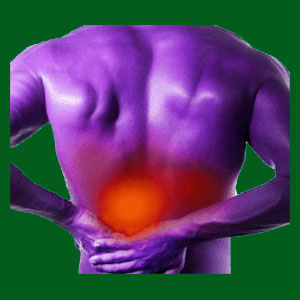
Spondylolisthesis tired muscles usually occur due to innervation problems or exhaustion accumulated from stabilizing a compromised spine. However, there are also other lesser known reasons why spondylolisthesis patients might experience focal or widespread muscular fatigue in relation to their vertebral slippage issue.
Chronic tiredness in the back muscles is not only functionally limiting, but can become a painful occurrence that might increase the chance for soft tissue injury. Repetitive injury of tired muscles may even lead to the development of a lifelong RSI problem, as we have witnessed throughout much of the modern medical sector.
This treatise explores the many reasons for patients to experience abnormally tired and possibly sore muscles as a result of spondylolisthesis.
Spondylolisthesis Tired Muscles Locations
In virtually all cases, chronic muscular tiredness occurs in cases of lumbar anterolisthesis. The forward progression of the condition is being held in check by the action of the lower postural muscles, which places inordinate strain on these tissues in stabilizing the spine. Of course, this is typically observed in significant cases of listhesis and is not really a major factor in minor vertebral slippage issues.
Muscular tiredness may be focal and located immediately around the affected vertebra. However, this presentation is rare, with most patients citing widespread fatigue throughout the lower paraspinal muscles, the buttocks muscles and often into the hips and upper legs. Some patients also cite fatigue in the oblique abdominal muscles.
Muscular tiredness in the neck is very atypical even in cases of severe cervical spondylolisthesis. However, it can occur and might follow the same causative patterns as lumbar listhesis detailed in the section below.
Spondylolisthesis Tired Muscles Explanations
There are 3 primary causes of chronic fatigue in the postural muscles in relation to a spondylolisthesis condition. 2 are direct consequences of the listhesis, while one is actually unrelated in anatomy, but instead is a result of mindbody interactions.
The first possible cause of tired muscles involves innervation issues caused by pinched nerves or central spinal stenosis enacted by the vertebral slippage. Severe cases of both anterolisthesis and retrolisthesis can misalign the central and neuroforaminal canals, potentially creating compression of neurological tissues. Since the postural muscles derive their nerve energy from these compressed tissues, they might feel weak, numb and exhausted all the time.
The most common structural cause of muscular exhaustion in relation to listhesis occurs in significant lumbar anterolisthesis presentations where the back muscles must work overtime to continually stabilize the spine as it is pulled forward by the affected vertebral bone. This type of tiredness is often seen in patients who work physical jobs or stand all day at work. Since the muscles do not receive much chance to rest, they develop patterns of chronic fatigue that can create the ideal circumstances for recurrent injury to occur, often resulting in an RSI diagnosis being rendered.
The least often diagnosed presentation of chronic muscular fatigue might be a result of mindbody ischemia of the postural muscles, creating a sore, exhausted feeling. These symptoms might be experienced alone or with other more substantial expressions, such as lower back pain or other neurological symptoms in the back, buttocks and legs. The mind is using the listhesis as an effective camouflage to create this type of syndrome, although the vertebral slippage is purely incidental to the presentation of subjective or objective weakness.
Spondylolisthesis Tired Muscles Solutions
Muscular tiredness that is caused by innervation concerns is often managed surgically. Typically, spinal fusion can realign the spine and restore nerve function. However, this procedure is very invasive and demonstrates a range of negative aspects to consider. Fusion should only be utilized in the very worst cases of grade 3 and 4 listhesis where no other therapeutic choice sands any hope for providing relief.
Chronic muscular tiredness from moderate to severe listhesis can be managed conservatively in most patients, as long as the spine remains stable and nerve functionality viable. There are physical therapy programs involving special stretches and exercises that can be very helpful, as can application of Alexander Technique and general postural correction therapy.
Ischemia-related fatigue is caused by a process that originates in the mind and this is where the causative issue must be treated. Trying to circumnavigate the psychogenic origin of ischemic weakness and pain will certainly result in poor therapeutic results, as well as an intensification or substitution of symptoms. Knowledge therapy is highly effective for ending mindbody pain syndromes and can be just as effective for decreasing the collateral consequences of chronic muscular fatigue.
Spondylolisthesis > Spondylolisthesis Symptoms > Spondylolisthesis Tired Muscles



